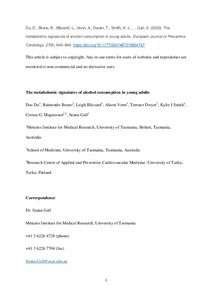The metabolomic signatures of alcohol consumption in young adults
Duc Du; Raimondo Bruno; Leigh Blizzard; Alison Venn; Terence Dwyer; Kylie J Smith; Costan G Magnussen; Seana Gall
https://urn.fi/URN:NBN:fi-fe2021042713733
Tiivistelmä
Background
Metabolomic analysis may help us to understand the association between alcohol consumption and cardio-metabolic health. We aimed to: (i) replicate a previous study of alcohol consumption and metabolic profiles, (ii) examine associations between types of alcoholic beverages and metabolites and (iii) include potential confounders not examined in previous studies.
Methods
Cross-sectional data of 1785 participants (age 26–36 years, 52% women) from the 2004–2006 Childhood Determinants of Adult Health study were used. Consumption of beer, wine and spirits was assessed by questionnaires. Metabolites were measured by a high-throughput nuclear magnetic resonance platform and multivariable linear regression examined their association with alcohol consumption (combined total and types) adjusted for covariates including socio-demographics, health behaviours and mental health.
Results
Alcohol consumption was associated with 23 out of 37 lipids, 12 out of 16 fatty acids and six out of 20 low-molecular-weight metabolites independent of confounders with similar associations for combined total alcohol consumption and different types of alcohol. Many metabolites (lipoprotein lipids in high-density lipoprotein (HDL) subclasses, HDL cholesterol, apolipoprotein A-1, phosphotriglycerides, total fatty acids, monounsaturated fatty acids, omega-3 fatty acids) had positive linear associations with alcohol consumption but some showed negative linear (low-density lipoprotein particle size, omega-6 fatty acids ratio to total fatty acids, citrate) or U-shaped (lipoprotein lipids in very-low-density lipoprotein (VLDL) subclasses, VLDL triglycerides) associations.
Conclusions
Our results were similar to those of the only previous study. Associations with metabolites were similar for total and types of alcohol. Alcohol consumption in young adults is related to a diverse range of metabolomic signatures associated with benefits and harms to health.
Kokoelmat
- Rinnakkaistallenteet [27094]
